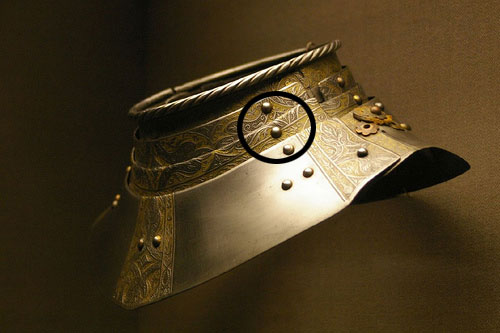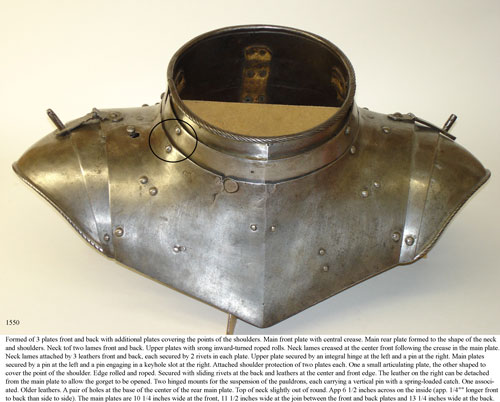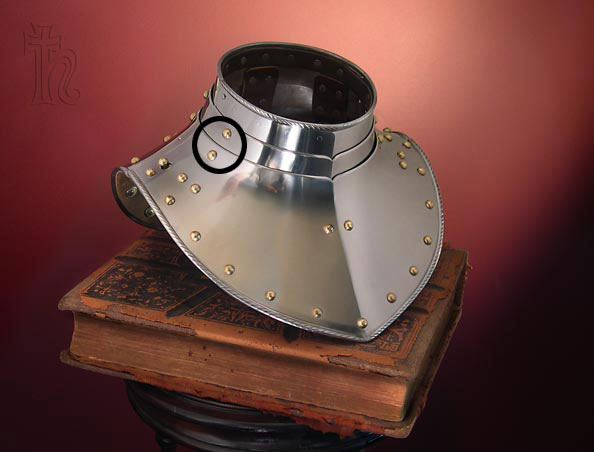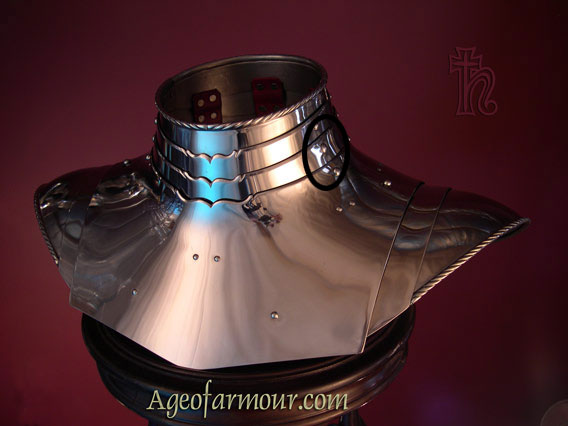Posts: 6 Location: Kelowna, BC, Canada
Wed 27 Oct, 2010 6:23 pm
Question about rivets on 15th/16th century gorget
Posts: 936 Location: WV
Wed 27 Oct, 2010 6:49 pm
arms & armour of the medieval knight by edge & paddock. page 180 shows you the inside of a gorget like you are picturing. each lame is riveted to the internal leather strap. the plates end just below where they overlap, allowing for a little bit of movement
Posts: 92 Location: Charles Town, WV
Wed 27 Oct, 2010 8:32 pm
Attached to the visible "face" plate, and a leather strap behind it. The lames overlap slightly but end before the rivet.
Posts: 33 Location: Washington
Thu 28 Oct, 2010 2:55 am
I always thought those rivets were ornamental, like the "blind" rivets in munions.
Isn't leather rigid enough to hold the plates in place?
Posts: 936 Location: WV
Thu 28 Oct, 2010 3:09 am
you know the more i look at it you maybe right. if you look at the inside of the gorgets and see the leather straps you see each one has 2 horizontal rivets in each lame of the neck. but you only see 1 rivet on the outside. i'm betting that the leather rivets are flush mounted and low on the lame while the round dome rivet is set higher on the lame
Posts: 307 Location: Ottawa, Canada
Thu 28 Oct, 2010 4:39 am
Those rivets are semi functional and semi-decorative. While fitting the lames together, a pin or bolt can be put through that hole into the lame underneath to hold it in place. Once the shape is finished, the hole in the lame behind is riveted to the leathers, and the visible hole is filled with a blind rivet. So on the finished piece, it serves no further purpose. During construction, it hold everything together.
Hope that helps.
Posts: 268 Location: Metro D.C.
Thu 28 Oct, 2010 7:13 am
I own one of Merctailors and was about to go take a pic when I remembered he had already posted a pic on his page...
picture is worth 1,000 words...
http://www.merctailor.com/catalog/popup_add_image.php?imagesID=15
In the pic you can see which ones are strapped and which ones are metal on metal and serve as pivot points
Posts: 307 Location: Ottawa, Canada
Thu 28 Oct, 2010 7:39 pm
That's certainly another way to do it.
The picture of the Wladislas gorget in Arms and Armour of the Medieval Knight shows a different set up, however. It is clearly related to the 2nd and 4th image posted by the OP. There is a full picture of the interior, and it only has straps, no steel on steel rivets on the lames.
Riveting the sides metal to metal allows forward and backward motion but limits ear to shoulder movement. Doing it all on leathers allows more freedom of movement. But during shaping, it's easier to make all the lames line up if they are pinned solidly in place, so you can hammer the overlapping edges into perfect alignment.
Posts: 6 Location: Kelowna, BC, Canada
Fri 29 Oct, 2010 8:43 am
craig:
what your saying (about limiting the side to side movement) makes perfect sense to me, which is why i'm asking before completing this new gorget. i have only built one like this before and on that one the only visible rivets are the hinge and bottom two on the strap. the function is great as i've fought in it many times, including the great practice we had last night.
have you actually built one with the lames riveted together during forming? if so, did you rivet it and then drill them out later or did you just use machine screws?
Posts: 307 Location: Ottawa, Canada
Fri 29 Oct, 2010 10:38 am
I used to work on occasion with an armourer named Scott Nichols, and I helped him construct several gorgets using this method, as well as some other pieces of articulated armour using the same premise.
Usually, we would use machine nuts and bolts as a temporary hold, but sometimes we also used quick rivets that we then drilled back out. Our decision on which to use was sometimes just based on which was closest to hand at the moment, but the quick rivets were sometimes better in tight places, too.
We never used proper peened rivets for this part of the process.
Scott was the real expert, so there may be more to it than that, but I distinctly remember him showing me pictures of historical examples with blind rivets lined up along the strap line and explaining what they were from. They consistently line up with the strap rivets, and there's almost always one row of blind rivets right over top of where there's a strap with two rows of rivets.
I hope that helps!
You
cannot post new topics in this forum
You
cannot reply to topics in this forum
You
cannot edit your posts in this forum
You
cannot delete your posts in this forum
You
cannot vote in polls in this forum
You
cannot attach files in this forum
You
can download files in this forum







